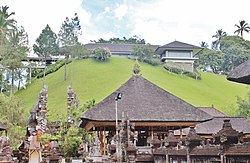| Tampaksiring Palace | |
|---|---|
Istana Tampaksiring | |
 Istana Tampaksiring, on a hill overlooking Pura Tirta Empul | |
 | |
| General information | |
| Architectural style | Modernism combined with Balinese architecture |
| Location | Jalan Tampaksiring, Manukaya, Tampaksiring Gianyar Regency, Bali 80552, Indonesia |
| Construction started | 1957-1963 |
| Client | Republic of Indonesia |
| Design and construction | |
| Architect(s) | R.M. Soedarsono |
The Tampaksiring Palace (Indonesian : Istana Tampaksiring) is one of 7 Presidential Palaces of Indonesia, it is located in Tampaksiring, Gianyar Regency, Bali. Built in 1957 and finished in 1963, [1] unlike other presidential palaces of Indonesia that mostly were inherited from the colonial period of Dutch East Indies, Istana Tampaksiring was built after the independence of Indonesia, and built not in colonial Indies Empire style, but in modernism combined with elements of Balinese architecture. [1]
Contents
The buildings of the complex are scattered around on an area covering 19 hectare. The main palace building are built on a higher ground overlooking Tampaksiring Tirta Empul Temple and Mount Agung. [2] [3]